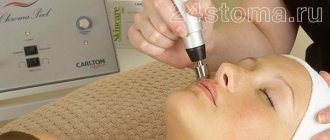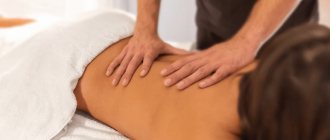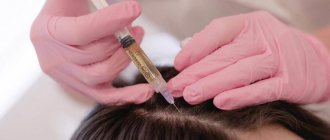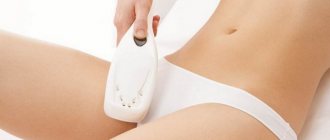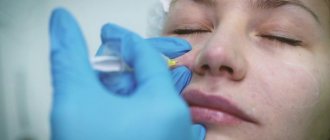Unwanted hairs in the intimate area always cause girls a lot of discomfort and difficulties, since it is difficult to remove them on your own, and hair removal itself is most often quite painful. Deep bikini photoepilation is a procedure with which you can achieve ideal smoothness of the skin in a sensitive area, while avoiding unwanted consequences. However, the technique has many features that are important to consider before performing it.
Pros and cons of bikini photoepilation
Bikini photoepilation is a salon technique aimed at removing unwanted hair in the intimate area. The procedure uses special equipment that directs high-frequency pulses to the root system of vegetation, promoting its gradual destruction.
The impulses are absorbed by the pigment melanin, which is contained in the structure of the hair follicles. Due to this, the hair follicle quickly heats up and spontaneously collapses.
Photoepilation of the bikini area is now performed quite often, since the technique has many advantages:
- Long-term retention of results. Typically, the effect of photoepilation lasts up to 3-4 years;
- Painless. The procedure does not cause the girl any discomfort; painkillers are also not used during its implementation;
- Safety. The high-frequency pulse acts exclusively on the hair follicles without damaging the skin itself in the treatment area;
- Minimum risks. Complications and side effects after photoepilation occur only if the contraindications prescribed for it are not observed;
- Positive effect on vegetation structure. With regular photoepilation, the hairs will gradually become thinner and softer, due to which the effect of the procedure will last longer.
In this case, photoepilation can be performed both in the classic bikini area and in the deep bikini area. This confirms its absolute safety and gentle effect on sensitive skin in the treatment area.
But consider the disadvantages of the technique:
- The need to complete the full course to achieve the desired result;
- High price;
- The need to comply with contraindications to the procedure and precautions prescribed after the session.
Also keep in mind that, despite the minimal risks of complications, they can still appear. This happens when the procedure is performed incorrectly or when low-quality equipment is used in the salon.
Operating principle
Regardless of the area being treated, the procedure is carried out based on the emission of safe light waves. Such impulses must have individual parameters (intensity, penetration depth) and depend on the characteristics of each patient, his skin type and hair structure. In this case, more pronounced results are formed while reducing the risk of developing a number of side effects.
The directed light acts directly on the hair bulb and shaft, destroying the special pigment melanin contained in them. Irreversible changes occur after the first time, despite the fact that the technique requires several sessions. Some of the excess vegetation dies off immediately, while others change, becoming thinner and more fragile in structure.
This partial result is explained by the fact that photoepilation works only at a certain stage of hair growth, in the growth phase. Since hair renewal occurs unevenly, it is logical to assume that it is impossible to form positive changes in just one session.
Contraindications to the procedure
Photoepilation of the deep bikini area is considered the most unsafe procedure, which is associated with the increased sensitivity of the treated area. Because of this, before performing it, it is important to pay attention to all contraindications and precautions prescribed by the cosmetologist.
There are quite a few health restrictions for photoepilation:
- Dermatological diseases.
- Infectious and chronic diseases.
- Pregnancy.
- Lactation.
- Tumors.
- Varicose veins
- Cardiovascular diseases.
- Fungus.
- Allergic reaction.
- Skin damage.
- IBS.
It is also recommended to consult a doctor before performing photoepilation. This way you can avoid unwanted consequences associated with non-compliance with contraindications to the technique.
Preparation for photoepilation
In order for photoepilation to be as effective as possible and not cause the girl pain, it is important to follow some recommendations for preparing for the session:
- A month before the procedure, avoid any methods of hair removal other than shaving;
- Two weeks before the session, do not sunbathe and use sunscreen to avoid exposure of the sensitive area to direct sunlight;
- Use the scrub in the bikini area 3 days before;
- 2 days before photoepilation, use a razor to remove hairs in the intimate area;
- Do not drink alcohol, energy drinks or coffee during the day.
You must follow the prescribed recommendations and restrictions before each session. This way you can not only avoid unwanted consequences after photoepilation, but also increase the efficiency of hair removal.
How many sessions are needed for complete hair removal?
Regarding the face, complete hair removal will require 2-4 sessions. Much more time is required if the hair is very thick and large areas of the body are treated - the back, legs, arms, at least 4-7 procedures. In each case, this is a certain number of events, which can reach 9-10 manipulations, different in time.
But using current technology, only those hairs that are in the active growth stage are eliminated. Consequently, repeated courses are envisaged, with the goal of destroying the awakened follicles of the remaining hair.
How is deep bikini photoepilation done?
Photoepilation always begins with an initial session, during which the cosmetologist examines the area of intended treatment and selects the optimal mode that will allow you to remove unwanted hairs as efficiently and quickly as possible.
At the session itself, the master makes sure that the girl has no contraindications and begins work:
- The skin is cleansed and treated with a disinfectant solution of Chlorhexidine.
- A special gel is applied to the bikini area.
- The master begins to move the photoepilation device over the skin, adjusting the frequency and density of the flash radiation.
- After treating the delicate area, it is cleared of the remnants of the previously applied gel and wiped with a special tonic.
- A soothing lotion is applied.
Typically, a photoepilation session takes no more than half an hour, and the girl feels absolutely no pain during it. Normal sensations during photoepilation are a sudden surge of heat to the treated area and a slight tingling sensation.
What to do after the procedure?
To increase the effectiveness of photoepilation and avoid skin problems in the treated area, the girl is prescribed some restrictions after the session:
- Avoid applying any skin care cosmetics for a day;
- Do not expose your bikini area to tan for two weeks;
- Avoid performing any method of hair removal other than shaving. It is especially not recommended to perform electrolysis or waxing within a week after the procedure;
- For 3 days, refuse to visit the bathhouse, sauna, or swimming pool.
It is important to follow the prescribed recommendations and restrictions after each photoepilation session, and also make sure that there are no contraindications for health reasons.
The essence of the impact
The effect of photoepilation is based on the hair's ability to perceive ultraviolet radiation. This happens due to the pigment melanin contained in the hair; dark hair has more of it, and light and gray hair has less of it. For this reason, the procedure will only be effective for those with dark hair, since other shades simply will not absorb the energy due. Negative reviews about the procedure are most often left by those girls who did not take this nuance into account.
After a beam of light with a certain wavelength and luminous flux power hits the hair, the light energy is converted into heat, in other words, the hair heats up. In this regard, its root is destroyed, and then completely dies. However, this does not happen immediately during the procedure; hairs fall out within one or two weeks, most often during water procedures.
Consequences of photoepilation
As a standard, photoepilation is an absolutely safe and gentle procedure, since only the root system of vegetation is affected. Sensitive skin in the bikini area is not damaged.
Because of this, consequences can only arise if contraindications for health reasons are not observed. They are then reflected in the well-being and general health of the girl.
After the session itself, a minor reaction may appear on the skin, which manifests itself in the form of the following side effects:
- Local redness;
- Increased skin sensitivity;
- Peeling;
- Slight swelling.
This reaction of the dermis usually subsides within 24 hours, without causing the girl much discomfort.
More serious complications can arise if the procedure is performed incorrectly by the cosmetologist. Then the girl will feel pain during the session itself and after it. In this case, if a serious skin reaction occurs, contact a specialist immediately to avoid complications.
Reviews
I finally decided to have bikini photoepilation and I’ll tell you that this turned out to be the most effective area for me, the result was visible after just 3 procedures, I think a couple more sessions and I’ll forget about it. Really, I’m really happy with the result on the bikini, I can just breathe out.
sima541
https://irecommend.ru/content/dlya-tekh-kto-umeet-zhdat-0
I did a deep bikini and armpits. Personally, my armpits hardly hurt, the result was excellent the first time. A deep bikini is WILDLY painful, the pubis is tolerable, and the lips and clitoral area are hell. The result on my pubic area turned out to be good, but in the area of the lips and clitoris - not so much, since my skin there is too dark, and my hair, due to long-term sugar hair removal, has a structure that is not suitable for photos.
Medusa Gorgon
https://www.woman.ru/beauty/body/thread/4044936/
I want to share my impressions about the photoepilation procedure... Exactly 3 years have passed since the first session, I don’t regret spending my time and money on it. The result is good. Now I recommend this procedure to all my advanced friends who are tired of dealing with this problem using “grandmother’s” methods. The procedure itself is a little uncomfortable, but it’s quite possible to wait half an hour and it’s not fatal. If your pain threshold is very low, you can ask for pain relief (I realized that this is important for the bikini area). In my opinion, waxing is much more painful, and the effect does not last long. Much depends on the level of the clinic (not a beauty salon or beauty salon) and the specialist; my doctor (I emphasize a dermatologist) did a wonderful job of carrying out the procedure, attentive and tactful, and also had time to chat with her. I recommend starting photoepilation in the off-season.
MARA 25
https://otzovik.com/review_559306.html
The procedure is quite delicate; the length of the hairs must be only a few millimeters, otherwise they will melt and stick to the device. Therefore, during the first procedure, the cosmetologist herself shaved off my hair, leaving a small stubble, oh, as I remember, it’s already embarrassing. Then they gave me goggles, put some cooling gel in there, and told me to start squealing if it hurt. There was no additional pain relief. The pain is felt, BUT! From the height of electrolysis, which I am doing at the moment, I want to say that it does not hurt at all! Well, or extremely tolerant. I “oohed” to myself, but didn’t show it or make a sound. But the girl at the reception complained that she also wanted to undergo photoepilation, but was very afraid of the pain. The procedure itself takes about half an hour - an hour for a deep bikini, it's quite fast. The coverage area of the tip of the device is the size of a thin rib of a matchbox, so the process goes quickly. After the first session, I didn’t notice the result at all; it began to appear from the third procedure. My hair began to fall out before my eyes, or rather, it fell on my underwear, its growth slowed down, and towards the end I stopped shaving it altogether, because there was nothing. After completing the required 8 sessions, I walked around happy for several months... until I saw new hairs. Yes, they were soft and light brown, the same as if I had never shaved them... But this is not permanent hair removal! Someone wrote that hair can grow back after 5 years, at least that way, but not in a few months. The thickness and length of my hair returned, I really wanted to cry, because I was sorry for the money spent.
Margarita Brusnikina
https://irecommend.ru/content/moya-istoriya-fotoepilyatsii-zony-bikini-chto-my-imeem-v-kontse-skolko-eto-stoilo-takzhe-ply
Photoepilation is very popular today due to its convenience and effectiveness. When carried out correctly, it does not injure the skin and does not cause any significant side effects. Daily use of a razor can lead to irritation on the skin, and the use of an epilator, wax or sugaring paste can cause ingrown hairs. Photoepilation will gradually and accurately destroy all unwanted vegetation without creating blemishes on the skin. At the same time, the procedure also has disadvantages, including the presence of contraindications, so before resorting to this method of removing unwanted hair, you must carefully study all its features.
Interested in visiting an LA salon to address unwanted body hair, but not sure how to calculate the cost of a session? The easiest way is to call our consultant. He will give you approximate prices.
Why exemplary? Because it is impossible to say in advance how many flashes are needed for laser hair removal of a particular area of skin. It depends on the type, color of hair, and its hardness.
For example, for men the procedure will be more expensive, since their follicles in the epidermis layer are deeper than those of women.
Indications for laser hair removal
- Fast hair growth
- Ingrown hair
- Professional requirements (eg sports)
- Irritation or discomfort after shaving or bioepilation
- You just want to forget about removing unwanted hair
- Recent skin damage (unhealed wounds, cuts)
- Inflammation, malignant formations
- Psoriasis and eczema
- Viral diseases of a cold nature
- Pregnancy and lactation period
Is it possible to do the procedure at home?
For photoepilation, special stationary equipment is used, which affects sensitive skin with high-frequency pulses. Only if the procedure is performed correctly will it be absolutely safe for you and will not cause side effects.
You cannot do photoepilation on your own, since careless use of the device for the procedure will not only negatively affect its effectiveness, but can also cause irritation, burns and other undesirable consequences.

